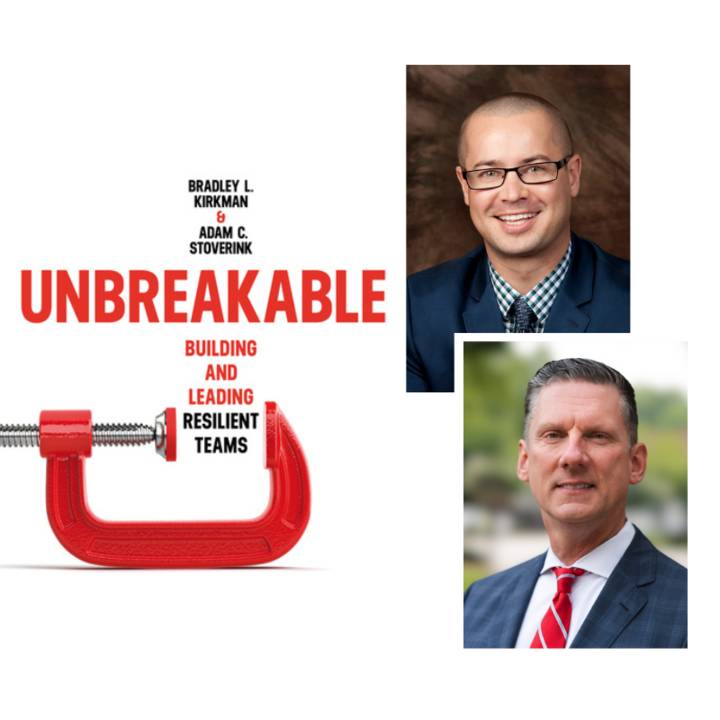Convergent technological disruption, rapidly changing (and often destabilizing) economic conditions, and increasingly active and demanding stakeholders.
These are just some of the challenges facing organizations and their leaders today. These challenges demand ever closer coordination within and between teams — and from their leaders.
But even the most effective teams face setbacks from time to time. What distinguishes truly successful teams from the rest is their resilience: the ability to bounce back when things don’t go their way.
In Unbreakable: Building and Leading Resilient Teams, Drs. Bradley Kirkman and Adam Stoverink offer a detailed roadmap for organizations and teams eager to increase their resilience and better overcome adversity. Unbreakable highlights insights and lessons on the subject of “team resilience,” an area that has lacked properly-dedicated research in the past. So, drawing upon decades of research into thousands of teams across dozens of sectors and industries, Unbreakable holds actionable lessons for team leaders and rank-and-file employees alike.
What Does It Mean to Build a Truly Resilient Team?
Every organization today operates in what the authors call volatile, uncertain, complex, and ambiguous (VUCA) business environments. Teams that deal well with adversity — and even thrive in the face of it — tend to have four crucial resources in reserve: confidence, teamwork roadmaps, an ability to improvise, and psychological safety.
Each resource contributes to “a team’s capacity to bounce back from a setback that results in a loss of valuable team processes,” write Kirkman and Stoverink. They enable teams and team leaders to continue three essential action processes:
- Coordination, which in this context means sequencing and timing team activities over variable timescales
- Monitoring, where team members hold one another accountable, communicate progress toward shared goals, and adjust those goals or strategies as needed.
- Backing up behavior is a critical leadership activity that involves “coaching, assisting, and helping (perhaps even replacing) teammates, as necessary.”
The unifying theme in each of these processes is teamwork itself. Resilient teams work well together, maximizing individual members’ strengths and overcoming weaknesses to create something greater than the sum of its parts.
“While it doesn’t hurt to have individually resilient people on a team, there are a totally separate set of factors that predict whether a team will be able to exhibit resiliency,” says Kirkman.
Teams tend to experience setbacks when these three processes break down, either in response to acute external challenges or a more gradual loss of internal capacity. This means it’s not enough for leaders to set a time-limited goal to establish team confidence, teamwork roadmaps, improvisational ability, and psychological safety at a particular point in time. Truly resilient teams maintain — and strengthen — these four resources over time.
The Benefits of Resilience for Leaders and Teams
In the introduction to Unbreakable, the authors tell the harrowing tale of the 1949 Mann Gulch inferno, which took the lives of more than a dozen smokejumpers in one of the 20th century’s worst wildland firefighting disasters.
Hellishly hot, deafeningly loud, and obscured by thick smoke, the Mann Gulch fire was the very definition of a VUCA scenario. Unbeknownst to the team, which had far more primitive monitoring technology than today’s firefighters, the fire dramatically expanded as the team approached the drop site. Still, forensic reconstruction of the disaster suggests that most, if not all, the day’s deaths could have been prevented had the team’s action processes not broken down once the firefighters hit the ground.
To his credit, team leader R. Wagner “Wag” Dodge had the confidence and improvisational ability to create an escape fire that saved him (and two teammates also escaped by being the first ones to realize the danger). But the team lacked a clear roadmap for what to do if they became separated and unable to communicate in a life-threatening situation. They lacked a survival plan. The root cause of this could have been limited psychological safety within the team, without which rank-and-file members might have felt uncomfortable pointing out a potential safety threat.
Lower-Stakes
Most teams don’t regularly operate in life-or-death scenarios like an out-of-control wildfire, of course. But Unbreakable shows that team resilience has clear benefits even in lower-stakes situations. They involve improved team performance, greater adaptability, and increased innovation.
According to Stoverink and Kirkman, resilient teams perform at a high level in good times and bad — not just when things are going well. They’re quicker to adapt to challenges and more capable of doing so. And they’re more likely to develop solutions that not only help them overcome the immediate setback but to avoid similar setbacks in the future. Most importantly, they build resilience together, taking cues from team and C suite-level leaders.
Challenges to Building Resilient Teams
Unbreakable describes in great detail what leaders must do to build resilient teams while acknowledging that the work is anything but easy.
Indeed, team and C suite-level leaders face a number of challenges in building resilient teams: rank-and-file resistance to change, lack of resources to effect such change, lack of buy-in from organizational leadership, and rank-and-file suspicion of leadership’s motives, among others.
Many of these challenges are rooted in longstanding cultural or behavioral dynamics that leaders have limited power to affect directly. For example, expressing emotion or even strong opinions was taboo for a long time in American workplaces. And it still is in many cases, even if it’s often to the team’s detriment.
“Most people feel uncomfortable being vulnerable in a team. In the past, showing emotion in the workplace was a sign of weakness,” says Kirkman. “In more recent years, we’ve learned there is a lot of courage that comes from showing vulnerability, which leads to greater bonding among team members and, therefore, greater team resilience.”
It’s natural for efficiency-minded leaders to try to overcome these challenges with well-meaning shortcuts. Seeking to reduce the “human element” of strategy shifts, they might implement overly aggressive process automations that actually hinder performance. Or, aiming for faster uptake, they might cultivate a false sense of urgency (or outright fear) that hits morale and increases attrition.
Any benefit from these “easy” fixes is outweighed by long-term damage to the organization. Plus, they are easily avoided by doing the more effective work of building and maintaining resilient teams.
How Unbreakable Can Help Leaders Build Resilient Teams
Every team is different, yes. But in researching thousands of teams across dozens of industries, Kirkman and Stoverink learned that they’re surprisingly alike in how they respond to adversity — and how resilience improves that response.
Unbreakable’s blueprint for building resilient teams advises leaders to focus on three specific capabilities:
- Sensemaking: This is the sort of intentional approach to decision-making and problem-solving that comes naturally to individuals. But it can easily break down within “brittle” teams. When confronted with a chaotic, confusing situation, the Mann Gulch firefighters lost their sensemaking capacity — with disastrous results.
- Coalescing: This is a fancy word for “cohesiveness,” or even more basically, “teamwork.” It’s the foundation of high-functioning teams. It depends on trust-based relationships among team members. And it’s a capability with long-term benefits. “At the end of our careers, if there is any value, it’s in our relationships,” says Stoverink.
- Persisting: Truly resilient teams dig deep in the face of adversity. And they keep going long after common sense tells them to quit.
Critically, these insights apply across a variety of industries, organizational structures, and business scenarios.
They work for teams whose work is inherently stressful and crisis-driven. These include emergency medical technicians, emergency department staff, firefighters and police, and business crisis response teams.
They apply to “ordinary” white-collar settings, like application development, legal services, and human resources. These settings require teams capable of running marathons — again and again.
They even make sense for teams where progress is measured in years rather than weeks. Those could include pharmaceutical development or large-scale infrastructure projects, for example, where setbacks can take months to overcome.
Unbreakable Teams Persist in the Face of Adversity
Recent history is filled with examples of once-powerful organizations that failed to innovate and suffered greatly.
Would they have been saved by the sort of broad-based resilience outlined in Unbreakable? Not all — nothing is a magic bullet, not even resilience. But things might have turned out differently for some. Because in a world where VUCA is the norm rather than the exception, resilient teams outperform brittle ones.
Resilient teams have four core resources: confidence, teamwork roadmaps, improvisational ability, and psychological safety. They continuously engage in three key team processes: coordination, monitoring, and backing up behavior (a vital leadership function). As a result, they make sense of their environments. They also coalesce around toward shared goals and persist in the face of adversity.
There’s a lot more to know about building resilient teams. This is why Unbreakable is an indispensable resource for leaders across industries. Perhaps it’s just what your team needs to gain an edge.
Featured Image Credit: Provided by the Author; Thank you!


